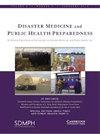Integrating Behavioral Health Into Monitoring and Surveillance During Public Health Emergencies: Challenges and Opportunities
IF 1.9
4区 医学
Q3 PUBLIC, ENVIRONMENTAL & OCCUPATIONAL HEALTH
引用次数: 0
Abstract
Objective Limited guidance exists for public health agencies to use existing data sources to conduct monitoring and surveillance of behavioral health (BH) in the context of public health emergencies (PHEs). Methods We conducted a literature review and environmental scan to identify existing data sources, indicators, and analytic methods that could be used for BH surveillance in PHEs. We conducted exploratory analyses and interviews with public health agencies to examine the utility of a subset of these data sources for BH surveillance in the PHE context. Results Our comprehensive search revealed no existing dedicated surveillance systems to monitor BH in the context of PHEs. However, there are a few data sources designed for other purposes that public health agencies could use to conduct BH surveillance at the substate level. Some of these sources contain lagging indicators of BH impacts of PHEs. Most do not consistently collect the sociodemographic data needed to explore PHEs’ inequitable impacts on subpopulations, including at the intersection of race, gender, and age. Conclusions Public health agencies have opportunities to strengthen BH surveillance in PHEs and build partnerships to act based on timely, geographically granular existing data.在公共卫生突发事件期间将行为健康纳入监测和监控:挑战与机遇
目标 公共卫生机构在公共卫生突发事件(PHE)中使用现有数据源对行为健康(BH)进行监测和监控的指导有限。方法 我们进行了文献综述和环境扫描,以确定可用于 PHE 中行为健康监控的现有数据源、指标和分析方法。我们对公共卫生机构进行了探索性分析和访谈,以研究这些数据源的子集在公共卫生紧急状况下用于生物卫生监测的实用性。结果 我们的综合搜索结果显示,目前还没有专门的监测系统用于监测公共卫生紧急状况下的保健卫生状况。不过,也有一些为其他目的而设计的数据源,公共卫生机构可以利用这些数据源在次州一级进行 BH 监测。其中一些数据源包含 PHEs 对 BH 影响的滞后指标。大多数数据源并没有持续收集必要的社会人口数据,以探讨公共卫生教育对亚人群的不公平影响,包括种族、性别和年龄的交叉影响。结论 公共卫生机构有机会加强 PHEs 中的 BH 监测,并建立合作关系,以便根据及时的、按地域划分的现有数据采取行动。
本文章由计算机程序翻译,如有差异,请以英文原文为准。
求助全文
约1分钟内获得全文
求助全文
来源期刊

Disaster Medicine and Public Health Preparedness
PUBLIC, ENVIRONMENTAL & OCCUPATIONAL HEALTH-
CiteScore
4.40
自引率
7.40%
发文量
258
审稿时长
6-12 weeks
期刊介绍:
Disaster Medicine and Public Health Preparedness is the first comprehensive and authoritative journal emphasizing public health preparedness and disaster response for all health care and public health professionals globally. The journal seeks to translate science into practice and integrate medical and public health perspectives. With the events of September 11, the subsequent anthrax attacks, the tsunami in Indonesia, hurricane Katrina, SARS and the H1N1 Influenza Pandemic, all health care and public health professionals must be prepared to respond to emergency situations. In support of these pressing public health needs, Disaster Medicine and Public Health Preparedness is committed to the medical and public health communities who are the stewards of the health and security of citizens worldwide.
 求助内容:
求助内容: 应助结果提醒方式:
应助结果提醒方式:


